Your browser does not fully support modern features. Please upgrade for a smoother experience.

Submitted Successfully!
Thank you for your contribution! You can also upload a video entry or images related to this topic.
For video creation, please contact our Academic Video Service.
| Version | Summary | Created by | Modification | Content Size | Created at | Operation |
|---|---|---|---|---|---|---|
| 1 | BaiQiao Chen | -- | 1839 | 2022-05-31 10:40:18 | | | |
| 2 | Vivi Li | + 26 word(s) | 1865 | 2022-06-01 03:53:23 | | |
Video Upload Options
We provide professional Academic Video Service to translate complex research into visually appealing presentations. Would you like to try it?
Cite
If you have any further questions, please contact Encyclopedia Editorial Office.
Chen, B.; Guedes Soares, C.; , . Develop Digital Twins for Subsea Pipelines. Encyclopedia. Available online: https://encyclopedia.pub/entry/23589 (accessed on 12 January 2026).
Chen B, Guedes Soares C, . Develop Digital Twins for Subsea Pipelines. Encyclopedia. Available at: https://encyclopedia.pub/entry/23589. Accessed January 12, 2026.
Chen, Baiqiao, Carlos Guedes Soares, . "Develop Digital Twins for Subsea Pipelines" Encyclopedia, https://encyclopedia.pub/entry/23589 (accessed January 12, 2026).
Chen, B., Guedes Soares, C., & , . (2022, May 31). Develop Digital Twins for Subsea Pipelines. In Encyclopedia. https://encyclopedia.pub/entry/23589
Chen, Baiqiao, et al. "Develop Digital Twins for Subsea Pipelines." Encyclopedia. Web. 31 May, 2022.
Copy Citation
Digital twins are described as a paradigm combining multi-physics modelling with data-driven analytics, which are used to mirror the life of its corresponding twin. Realistic virtual models of structural systems are shown to bridge the gap between design and construction and to mirror the real and virtual worlds. The concept of the digital twin has also been used in offshore structures as platforms and subsea pipelines throughout the stages of construction and operation life.
digital twin
subsea pipeline
IoT
maintenance
1. Introduction
Subsea pipelines are the flowlines connecting a subsea wellhead to a manifold or a platform, or the export lines (trunk lines) used as a long-distance transportation system for the oil and gas [1][2]. Important considerations of the pipeline system are the efficient operation and the development of the system for future needs. Due to the low price of oil in recent years, oil and gas field operators are looking beyond the traditional operational maintenance strategy for the sake of reducing the downtime caused by the planned or sometimes unplanned preventive maintenance in the production field, thus reducing the operational cost (OPEX) [3][4].
In the digital solutions to subsea integrity management (SIM), the use and management of data bring benefits to the daily operations, e.g., the increased efficiency, optimization, reduction in cost, and safety [3]. New technologies and associated processes are required for increased safety and better monitoring of the subsea assets.
Recent advancements in information and communication technologies, including cloud computing, high-performance processors, high dimensional visualization capabilities, internet of things (IoT), wearable technologies, additive manufacturing (AM), big data analytics (BDA), artificial intelligence (AI), autonomous robotic systems, submarine drones, and blockchain technology, have catalysed digital adoption across industries. These new technologies have facilitated the cyber-physical integration by which data can be collected, analysed, and visualized to make informed decisions and to serve as a basis for simulations to optimize operations [5]. The concept of cyber-physical interaction and associated simulation is referred to as a Digital Twin.
The digital twin draws considerable interest as it can provide a cost-effective, reliable and intelligent maintenance strategy based on the machine learning (ML) algorithm [4] and assess extension life projects. The digital twin concept consists of three components: (1) the physical asset, (2) the virtual representation of the asset, and (3) the connection between the previous two components. The connection includes the information transferred from the physical asset to the digital twin and from the digital twin to the asset. A clear business purpose is a key principle in the development of digital twins to provide value [3].
2. Digital Twin
A digital twin is defined as one virtual representation of a system (or an asset) that can be used to calculate the states of the system and to make the information available. The integrated models and data of the digital twin can provide decision support over the life cycle of the system or asset. The idea to use a twin model can be dated back to the 1970s when two identical space vehicles were built in NASA’s Apollo program to allow for mirroring of the conditions of the space vehicle [6].
Although the concept of digital twins was first put forward in 1991 [7], the model of the digital twin was first introduced in 2002 as a concept for product lifecycle management (PLM). After its initial names of mirrored spaces model (MSM) and information mirroring model (IMM), the model was finally referred to as the Digital Twin in 2011 [8].
The digital twin has been applied to a wide range of industries including aerospace [9][10], automotive [11][12], healthcare [13][14][15][16], manufacturing [17][18][19], and smart city [20][21]. Some early applications of the digital twin can be found in NASA’s spacecraft [22][23][24] and in the US Air Force’s jet fighters [25]. More recently, world-class vendors such as Dassault Systèmes, PTC, and Siemens use the digital twin concept in their PLM. The digital twin model was also proposed for the robust deployment of IoT [26]. Aiming at developing digital twins for all built cars, TESLA enabled synchronous data transmission between their cars and the factory [27]. From 2017 to 2019, the Gartner listed the digital twin as being among the top 10 strategic technology trends and indicated that billions of things would have their digital twins within 3–5 years [28][29][30].
Although the concept of the digital twin is not new, it was more a descriptive one and lacked auxiliary technologies in the first few years [31][32][33]. Figure 1 shows the number of results obtained by searching “digital twin” as a “topic” in the Web of Science database, indicating a tremendous increase of research interest in the digital twin both in industry and academia, especially since 2017/2018. In terms of the country of study, China is the leading country in publications on the digital twin, followed by Germany and the USA.
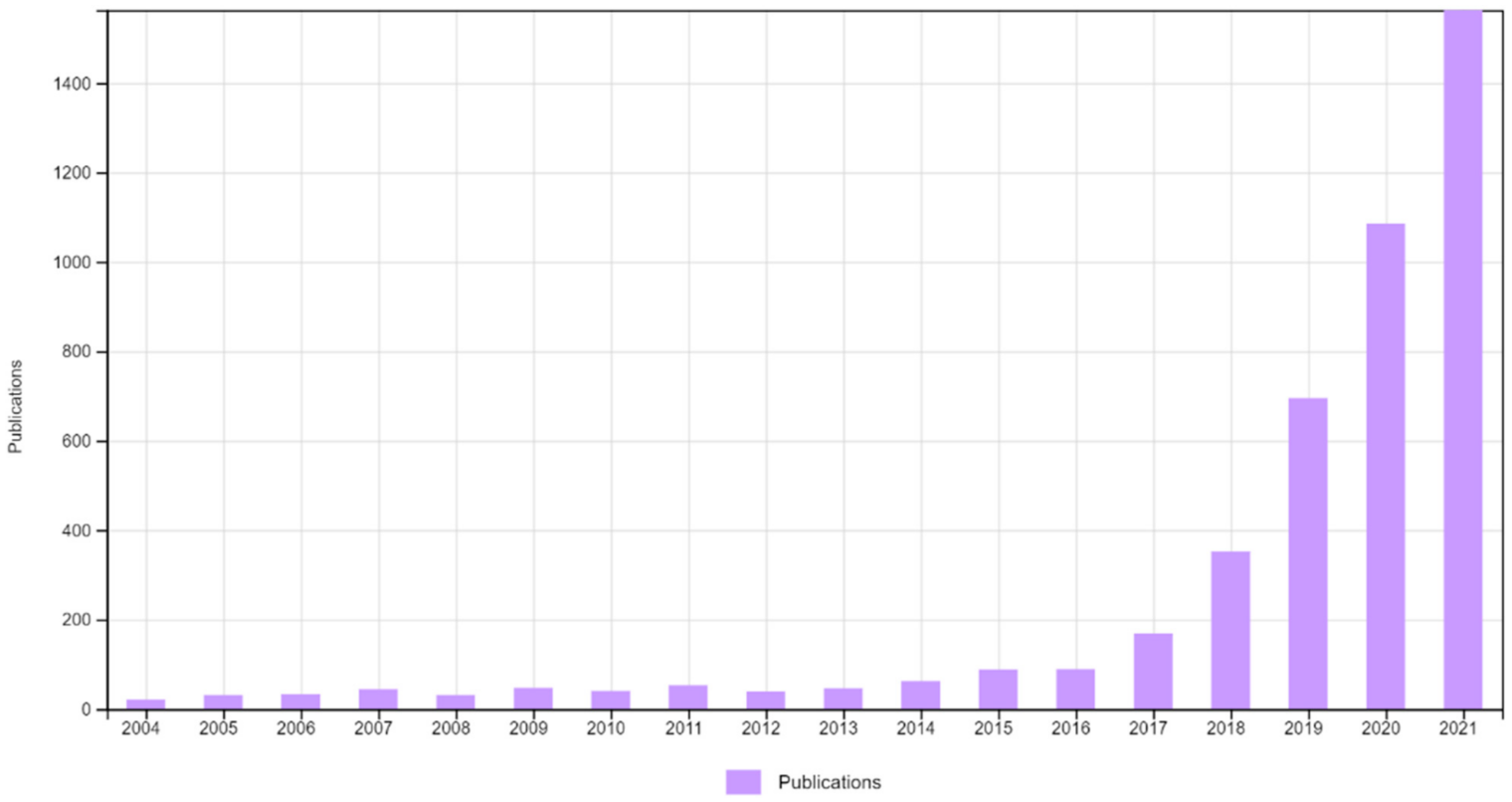
Figure 1. The number of published results about digital twins in the Web of Science.
Even though the digital twin technologies are of interest to companies in the industry, a major part of the studies (about 79%) are conducted by researchers in academia, according to a survey [34]. Most academic research focuses on improving modelling techniques rather than optimizing data and implementing digital twins. Only 6% of the articles are initiated in the industry; the remaining are collaborative studies between academia and industry. There are few connections between industry and academia, particularly due to commercial secrecy.
To meet the new requirement from applications, Tao et al. [35] presented an extended five-dimension digital twin model, adding data and services to the initial three-dimensional digital twin concept. Figure 2 shows the key technologies for modelling each dimension of the digital twin. Qi et al. [36] classified the tools for the service applications of digital twins into platform service tools, simulation service tools, optimization service tools, and diagnostic and prognosis service tools. A list of the tools for each category is shown in Figure 3.
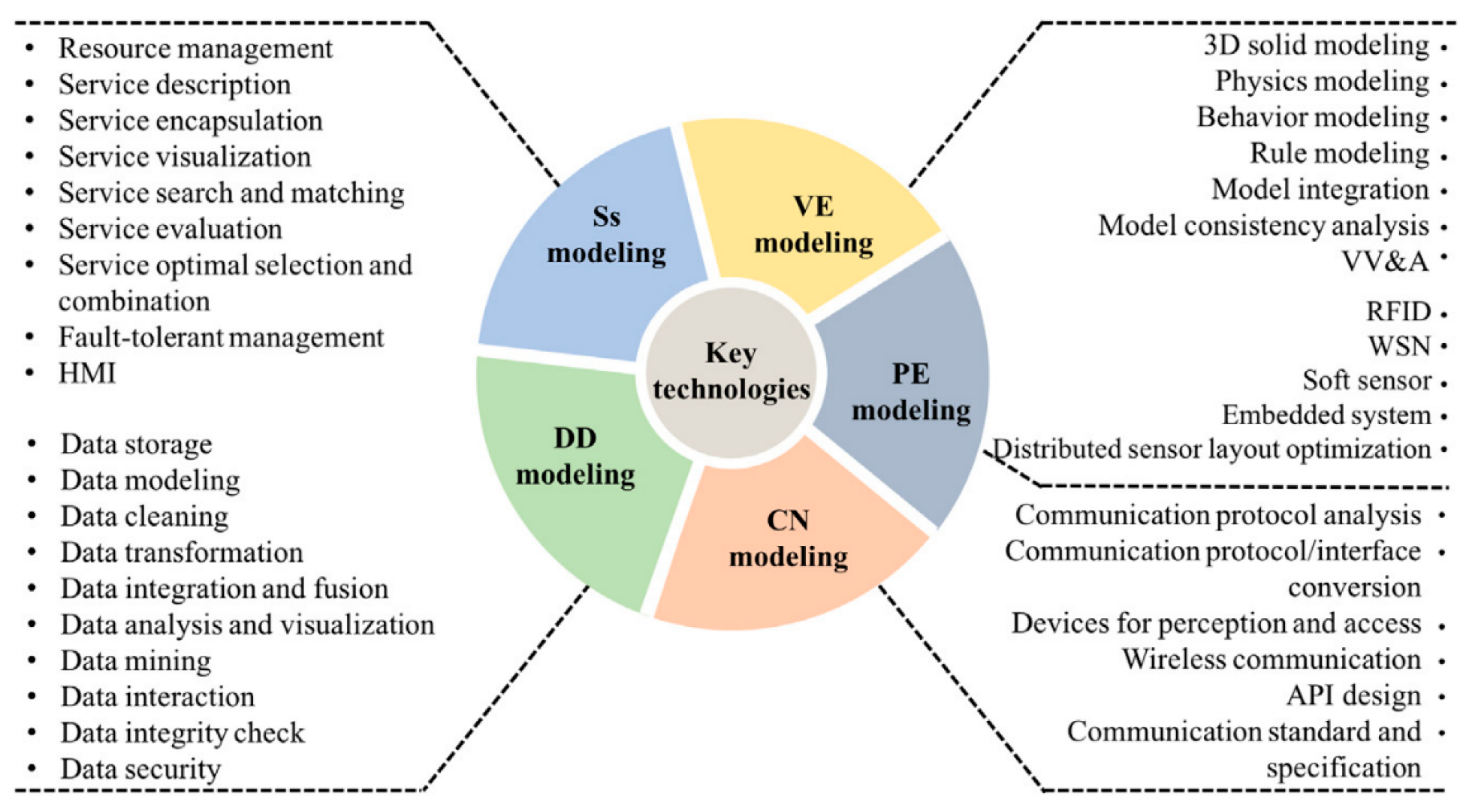
Figure 2. Five-dimensional digital twin model and the key technologies. PE—Physical Entity, VE—Virtual Entity, Ss—Services, DD—Digital twin data, CN—Connection. Reproduced from [35], with permission from Elsevier, 2022.
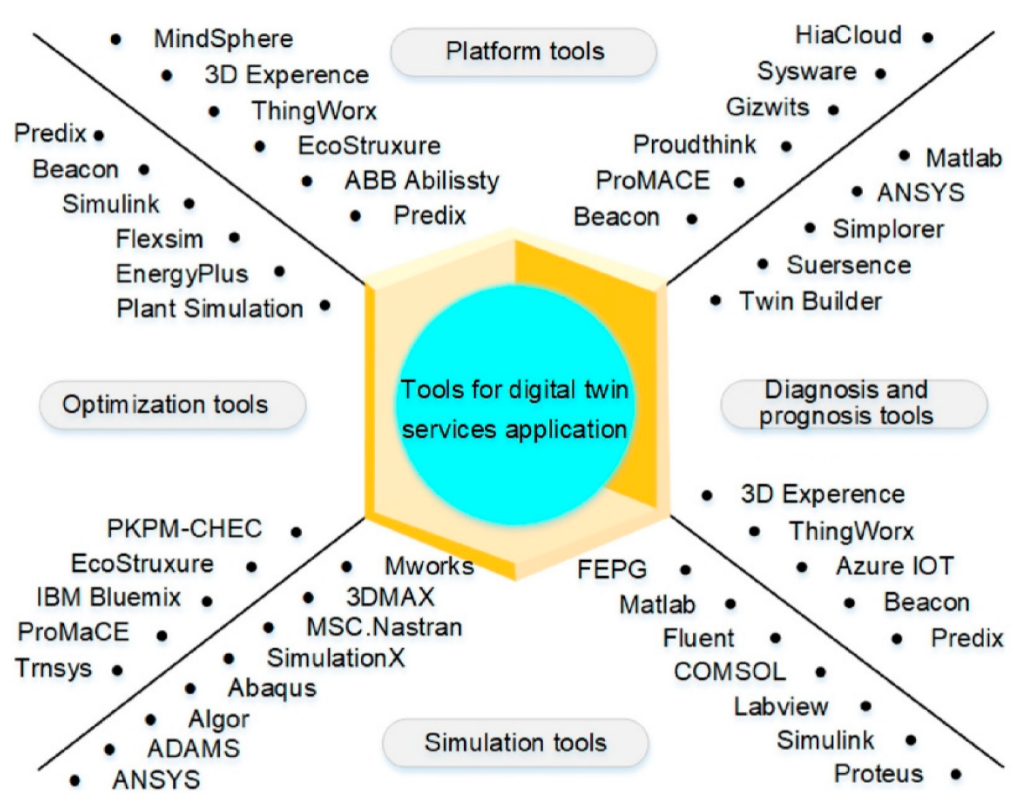
Figure 3. The tools for services applications of digital twins. Reproduced from [36], with permission from Elsevier, 2022.
ANSYS Twin Builder is one of the multi-physics simulation packages used to add physical realism to the digital twins [27]. It contains extensive application-specific libraries and features third-party tool integration and can enable engineers to quickly build, validate and deploy the digital models of physical assets at an appropriate level of detail.
As with all new concepts, there are also obstacles to the further application of the digital twin. For instance, it is sometimes difficult to collect the most important data from thousands of sensors that track vibration, temperature, environmental conditions, force, speed, or power. In addition, the data can be spread among different owners in various formats. Consequently, the digital twin may fail to echo what is going on in the real world, leading to poor decisions made by the managers accordingly [37]. In this regard, further research is needed for improved data collection and processing methods to implement the communication interface between the digital and the physical twins. In terms of standardization, the development of universal platforms and tools are also required for further applications of digital twins.
3. Subsea Pipelines and Application of Digital Twin
The first oil pipeline is widely believed to have been installed in the 1860s in the USA to transport crude oil [38]. Since then, subsea pipelines have become the most economical means of efficiently transporting crude oil, natural gas, and other products from offshore installations for the exploitation of subsea reservoirs. Figure 4 illustrates different uses of subsea pipelines associated with platforms and wells, including the infield flowlines and export pipelines.
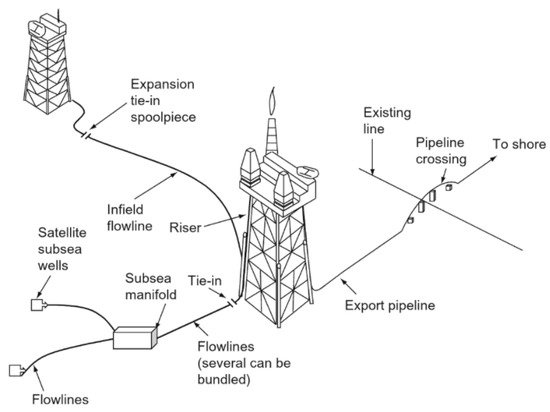
Figure 4. Uses of subsea pipelines. Reproduced from [38], with permission from Elsevier, 2022.
In a harsh sea environment, sufficient structural strength is necessary for designing, analysing, and operating subsea pipelines to guarantee the safety and integrity of subsea pipelines [38][39] throughout their life span.
Pipeline design is affected by multiple factors identified during the early stages (i.e., conceptualization, front end engineering and design stage, and detailed engineering phase). These factors include the site selection, route survey, local environmental conditions, material selection, wall-thickness design, pipeline protections, and the budget of the project [40][41]. During the pipelay process, the pipelines are deposited from installation vessels, with new pipe segments welded to form the pipelines. A proper pipe-lay is required to avoid excessive bending stresses that may cause fractures and buckling. The low temperature on the seafloor can sometimes cause a global contraction of the pipeline, while heat coming up from the reservoir fluid may induce local thermal expansion of the pipeline [42][43]. Temperature or pressure changes in the operation process can also cause “pipeline walking” [44][45] in the case of improper restraints of the pipelines. Corrosion and erosion, which occur due to chemical attacks and abrasion from the internal fluids, are one of the major limiting factors in the continued operation of subsea pipelines [46][47][48][49][50]. These factors necessitate the routine inspection of subsea pipelines and the use of monitoring technologies.
According to the B31G code [51] of the American Society of Mechanical Engineers (ASME), the geometry of the corrosion pits can be idealized as elliptical shapes, and a bulging factor can be applied when considering the defect geometry. The class society Det Norske Veritas (DNV) headquartered in Norway published the standard ST-F101 [52] and also one document of recommended practice RP-F101 [53] for pipeline applications. The American Petroleum Institute (API) Specification 5L [54] includes the requirements for manufacturing seamless and welded steel pipes in the transportation of oil and gas. One current challenge for subsea pipeline inspection is the often-deep waters.
More recently, sandwich pipes (SPs) were proposed as an effective alternative to the pipe-in-pipe (PIP) system for ultra-deepwater applications [55][56][57]. In the SPs, a polyester foam material with low density and heat-conducting ability is filled between two metal pipes, providing high structural resistance with thermal insulation capability [58][59][60][61].
As reported by DNV [3], the recent digitalization requires the reduced cost of sensor technology and computational power, as well as cloud storage and computing. Figure 5 illustrates the main technologies and enablers in digitalization for SIM: digital worker + support, inspection + data collection, and the analysis.
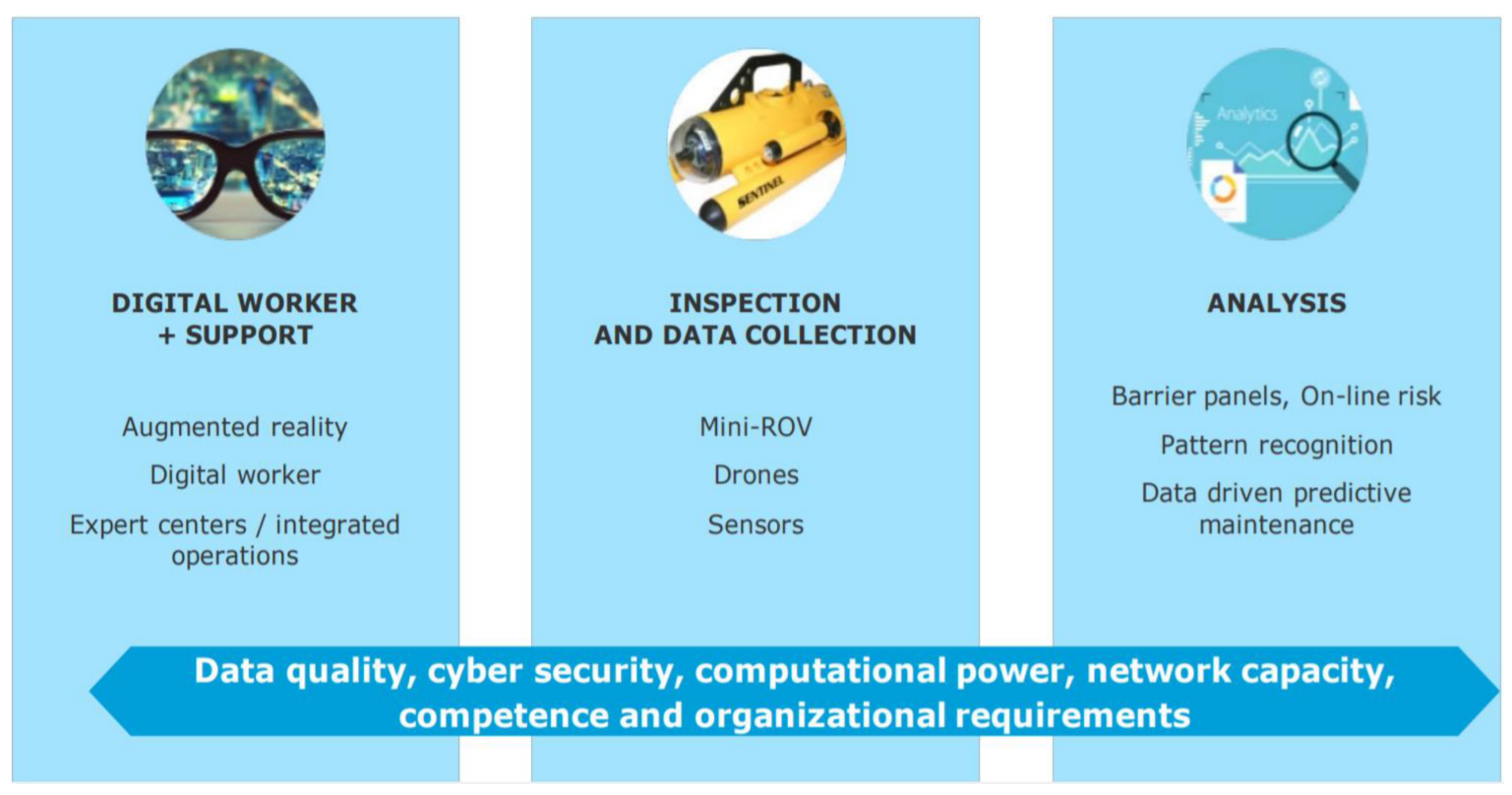
Figure 5. The key enablers for digitalization in subsea integrity management [3].
DNV define in the RP-A204 [62] six levels of capability (stages of the evolution) of digital twins, as illustrated in Figure 6. Real-time data streams are not required in Level 0 (standalone) but are in Level 1 (descriptive capability). Level 2 (diagnostic capability) provides support to monitor the conditions and detect the fault, together with troubleshooting. Health and condition indicators are further enriched in Level 3 (predictive) to support prognostic capabilities. Level 4 (prescriptive capability) can be used to provide recommended actions based on the predictions. In Level 5 (autonomous capability), the users can determine the functional element to perform actions or make decisions regarding the system.
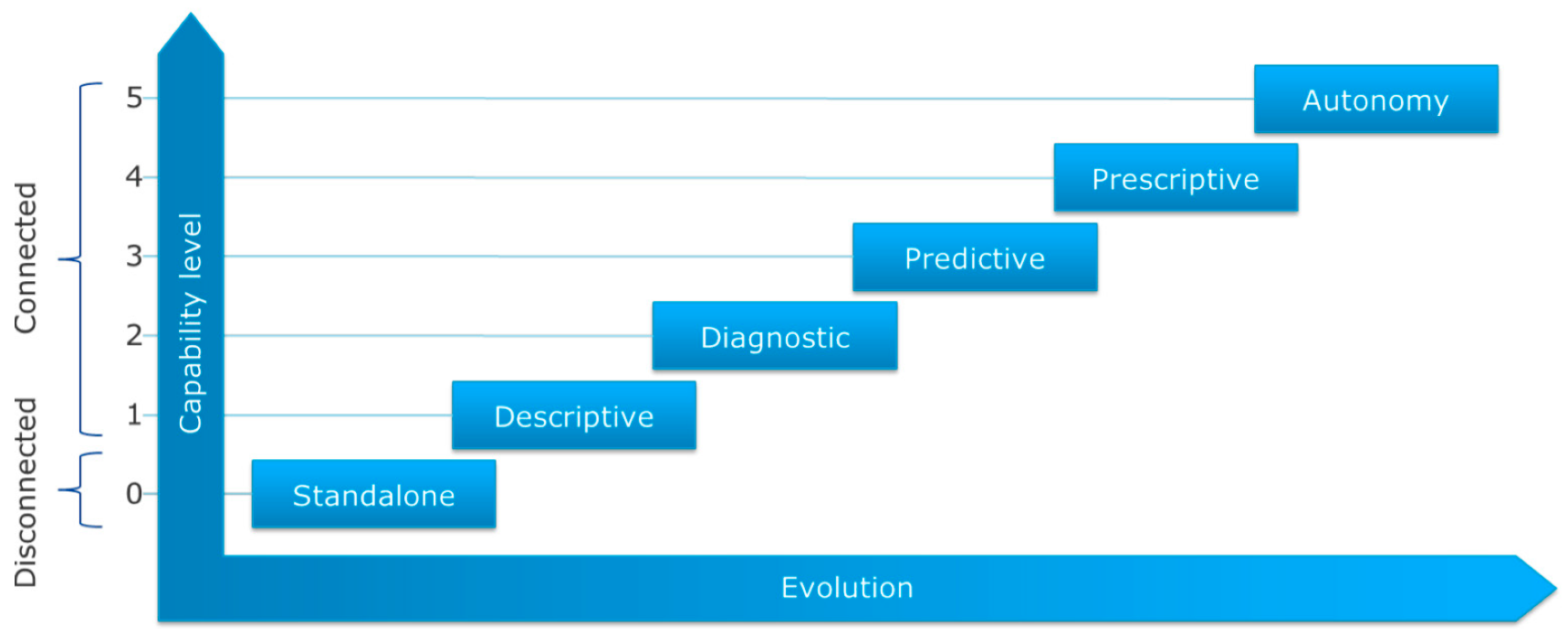
Figure 6. The capability levels of the digital twins at different stages of the evolution [62].
The digitalization of the data exchanges of the subsea pipelines plays an important role in avoiding the errors of the data during manual transcriptions. In order to simplify the data exchange between parties at the different stages of projects, the pipeline data exchange format (PDEF) collaborative initiative was proposed. It is an open-source joint industry project (JIP) involving many companies in the pipeline industry, aiming at developing a standard format for the exchange of the data and describing the data used in the design of subsea pipelines [3].
References
- Silva, L.M.R.; Guedes Soares, C. An integrated optimization of the floating and subsea layouts. Ocean Eng. 2019, 191, 106557.
- Silva, L.M.R.; Guedes Soares, C. Oilfield development system optimization under reservoir production uncertainty. Ocean Eng. 2021, 225, 108758.
- DNV GL. 2020/1022: How Digital Tools and Solutions Can Improve Subsea Integrity Management; DNV GL: Oslo, Norway, 2020.
- Bhowmik, S. Digital twin of subsea pipelines: Conceptual design integrating IoT, machine learning and data analytics. In Proceedings of the Annual Offshore Technology Conference 2019, Houston, TX, USA, 6–9 May 2019.
- Wanasinghe, T.R.; Wroblewski, L.; Petersen, B.K.; Gosine, R.G.; James, L.A.; de Silva, O.; Mann, G.K.I.; Warrian, P.J. Digital Twin for the Oil and Gas Industry: Overview, Research Trends, Opportunities, and Challenges. IEEE Access 2020, 8, 104175–104197.
- Rosen, R.; von Wichert, G.; Lo, G.; Bettenhausen, K.D. About the importance of autonomy and digital twins for the future of manufacturing. IFAC-PapersOnLine 2015, 48, 567–572.
- Gelernter, D.H. Mirror Worlds: Or the Day Software Puts the Universe in a Shoebox—How It Will Happen and What It Will Mean; Oxford University Press: New York, NY, USA, 1993; OCLC 23868481; ISBN 978-0195079067.
- Grieves, M. Virtually intelligent product systems: Digital and physical twins. In Complex Systems Engineering: Theory and Practice; Flumerfelt, S., Schwartz, K.G., Mavris, D., Briceno, S., Eds.; American Institute of Aeronautics and Astronautics: Reston, VA, USA, 2019; pp. 175–200.
- Li, C.; Mahadevan, S.; Ling, Y.; Choze, S.; Wang, L. Dynamic Bayesian network for aircraft wing health. AIAA J. 2017, 55, 930–941.
- Mandolla, C.; Messeni, A.; Percoco, G.; Urbinati, A. Computers in Industry Building a digital twin for additive manufacturing through the exploitation of blockchain: A case analysis of the aircraft industry. Comput. Ind. 2019, 109, 134–152.
- Magargle, R.; Johnson, L.; Mandloi, P.; Davoudabadi, P.; Kesarkar, O.; Krishnaswamy, S.; Batteh, J.; Pitchaikani, A. A simulation based digital twin for model-driven health monitoring and predictive maintenance of an automotive braking system. In Proceedings of the 12th International Modelica Conference, Prague, Czech Republic, 15–17 May 2017; pp. 35–46.
- Damjanovic-Behrendt, V. A digital twin-based privacy enhancement mechanism for the automotive industry. In Proceedings of the International Conference on Intelligent Systems (IS), Madeira, Portugal, 25–27 September 2018; pp. 272–279.
- Torkamani, A.; Andersen, K.G.; Steinhubl, S.R.; Topol, E.J. High-definition medicine. Cell 2017, 170, 828–843.
- Liu, Y.; Zhang, L.; Yang, Y.; Zhou, L.; Ren, L.; Wang, F.; Liu, R.; Pang, Z.; Deen, M.J. A novel cloud-based framework for the elderly healthcare services using digital twin. IEEE Access 2019, 7, 49088–49101.
- Laaki, H.; Miche, Y.; Tammi, K. Prototyping a digital twin for real time remote control over mobile networks: Application of remote surgery. IEEE Access 2019, 7, 20325–20336.
- Jimenez, J.I.; Jahankhani, H.; Kendzierskyj, S. Health care in the cyberspace: Medical cyber-physical system and digital twin challenges. In Digital Twin Technologies and Smart Cities; Springer: Cham, Switzerland, 2020; pp. 79–92.
- Post, J.; Groen, M.; Klaseboer, G. Physical model based digital twins in manufacturing processes. In Proceedings of the 10th Forming Technology Forum, Enschede, The Netherlands, 12–13 October 2017.
- Howard, D. The digital twin: Virtual validation in electronics development and design. In Proceedings of the 2019 Pan Pacific Microelectronics Symposium, Kauai, HI, USA, 11–14 February 2019; pp. 1–9.
- Bilberg, A.; Malik, A.A. Digital twin driven human-robot collaborative assembly. CIRP Ann. 2019, 68, 499–502.
- Mohammadi, N.; Taylor, J.E. Smart city digital twins. In Proceedings of the 2017 IEEE Symposium Series on Computational Intelligence (SSCI), Honolulu, HI, USA, 27 November–1 December 2017; pp. 1–5.
- Ruohomäki, T.; Airaksinen, E.; Huuska, P.; Kesäniemi, O.; Martikka, M.; Suomisto, J. Smart city platform enabling digital twin. In Proceedings of the International Conference on Intelligent Systems (IS), Madeira, Portugal, 25–27 September 2018; pp. 155–161.
- Piascik, R.; Vickers, J.; Lowry, D.; Scotti, S.; Stewart, J.; Calomino, A. Technology Area 12: Materials, Structures, Mechanical Systems, and Manufacturing Road Map; NASA Office of Chief Technologist: Washington, DC, USA, 2010.
- Caruso, P.; Dumbacher, D.; Grieves, M. Product lifecycle management and the quest for sustainable space exploration. In Proceedings of the AIAA SPACE 2010 Conference & Exposition, Anaheim, CA, USA, 30 August–2 September 2010.
- Glaessgen, E.; Stargel, D. The digital twin paradigm for future NASA and US Air Force vehicles. In Proceedings of the 53rd AI—AA/ASME/ASCE/AHS/ASC Structures, Structural Dynamics and Materials Conference, Honolulu, HI, USA, 23–26 April 2012.
- Tuegel, E. The airframe digital twin: Some challenges to realization. In Proceedings of the 53rd AIAA/ASME/ASCE/AHS/ASC Structures, Structural Dynamics and Materials Conference, Honolulu, HI, USA, 23–26 April 2012.
- Maher, D.P. On software standards and solutions for a trusted Internet of Things. In Proceedings of the 51st Hawaii International Conference on System Sciences (HICSS-51), Waikoloa Village, HI, USA, 3–6 January 2018.
- Chen, B.Q.; Videiro, P.M.; Guedes Soares, C. Review of digital twin of ships and offshore structures. In Developments in Maritime Technology and Engineering; Guedes Soares, C., Santos, T.A., Eds.; Taylor and Francis: London, UK, 2021; pp. 445–451.
- Panetta, K. Gartners Top 10 Technology Trends for 2017. Available online: https://www.gartner.com/smarterwithgartner/gartners-top-10-technology-trends-2017/ (accessed on 27 January 2022).
- Cearley, D.W.; Walker, M.J.; Blosch, M. Top 10 Strategic Technology Trends for 2018; Gartner: Stamford, CT, USA, 2017.
- Panetta, K. Gartner Top 10 Strategic Technology Trends for 2019. Available online: https://www.gartner.com/smarterwithgartner/gartners-top-10-technology-trends-2019/ (accessed on 27 January 2022).
- Liu, M.; Fang, S.; Dong, H.; Xu, C. Review of digital twin about concepts, technologies, and industrial applications. J. Manuf. Syst. 2021, 58, 346–361.
- Son, Y.H.; Kim, G.-Y.; Kim, H.C.; Jun, C.; Noh, S. Do Past, present, and future research of digital twin for smart manufacturing. J. Comput. Des. Eng. 2021, 9, 1–23.
- Wang, J.; Li, X.; Wang, P.; Liu, Q. Bibliometric analysis of digital twin literature: A review of influencing factors and conceptual structure. Technol. Anal. Strateg. Manag. 2022, 1–15.
- Atalay, M.; Murat, U.; Oksuz, B.; Parlaktuna, A.M.; Pisirir, E.; Testik, M.C. Digital twins in manufacturing: Systematic literature review for physical-digital layer categorization and future research directions. Int. J. Comput. Integr. Manuf. 2022, 1–27.
- Tao, F.; Zhang, M.; Nee, A.Y.C. Five-dimension digital twin modeling and its key technologies. Digit. Twin Driven Smart Manuf. 2019, 63–81.
- Qi, Q.; Tao, F.; Hu, T.; Anwer, N.; Liu, A.; Wei, Y.; Wang, L.; Nee, A.Y.C. Enabling technologies and tools for digital twin. J. Manuf. Syst. 2021, 58, 3–21.
- Tao, F.; Qi, Q. Make more digital twins. Nature 2019, 573, 490–491.
- Guo, B.; Song, S.; Ghalambor, A.; Lin, T.R. Offshore Pipelines: Design, Installation, and Maintenance; Gulf Professional Publishing: Houston, TX, USA, 2013.
- Cai, J.; Jiang, X.; Lodewijks, G. Residual ultimate strength of offshore metallic pipelines with structural damage–a literature review. Ships Offshore Struct. 2017, 12, 1037–1055.
- Bai, Q.; Bai, Y. Subsea Pipeline Design, Analysis, and Installation; Gulf Professional Publishing: Waltham, MA, USA, 2014.
- Yazdi, M.; Khan, F.; Abbassi, R. Operational subsea pipeline assessment affected by multiple defects of microbiologically influenced corrosion. Process Saf. Environ. Prot. 2022, 158, 159–171.
- Wang, Z.; Tang, Y.; Guedes Soares, C. Imperfection study on lateral thermal buckling of subsea pipeline triggered by a distributed buoyancy section. Mar. Struct. 2021, 76, 102916.
- Wang, Z.; Tang, Y.; Yang, J.; Guedes Soares, C. Analytical study of thermal upheaval buckling for free spanning pipelines. Ocean Eng. 2020, 218, 108220.
- Bruton, D.A.; Bolton, M.; Carr, M.; White, D. Pipe-soil interaction with flowlines during lateral buckling and pipeline walking —The SAFEBUCK JIP. In Proceedings of the Offshore Technology Conference, Houston, TX, USA, 5–8 May 2008.
- Bruton, D.A.; Carr, M.; Sinclair, F.; MacRae, I. Lessons learned from observing walking of pipelines with lateral buckles, including new driving mechanisms and updated analysis models. In Proceedings of the Offshore Technology Conference, Houston, TX, USA, 3–6 May 2010.
- Chen, B.; Zhang, X.; Guedes Soares, C. The effect of general and localized corrosions on the collapse pressure of subsea pipelines. Ocean Eng. 2022, 247, 110719.
- Zhang, X.; Chen, B.; Guedes Soares, C. Effect of non-symmetrical corrosion imperfection on the collapse pressure of subsea pipelines. Mar. Struct. 2020, 73, 102806.
- Teixeira, A.P.; Guedes Soares, C.; Netto, T.A.; Estefen, S.F. Reliability of pipelines with corrosion defects. Int. J. Press. Vessel. Pip. 2008, 85, 228–237.
- Teixeira, A.P.; Palencia, O.G.; Guedes Soares, C. Reliability analysis of pipelines with local corrosion defects under external pressure. J. Offshore Mech. Arct. Eng. 2019, 141, 1–10.
- Netto, T.A. On the effect of narrow and long corrosion defects on the collapse pressure of pipelines. Appl. Ocean Res. 2009, 31, 75–81.
- ASME. B31G Manual for Determining the Remaining Strength of Corroded Pipelines (Supplement to ASME B31 Code for Pressure Piping); The American Society of Mechanical Engineers: New York, NY, USA, 2012.
- DNV. Recommended Practice DNV-RP-F101: Corroded Pipelines; DNV: Oslo, Norway, 2019.
- DNV. Standard DNV-ST-F101: Submarine Pipeline Systems; DNV: Oslo, Norway, 2021.
- American Petroleum Institute. API Specification 5L—Line Pipe, 46th ed.; American Petroleum Institute: Washington, DC, USA, 2018.
- Li, R.; Chen, B.; Guedes Soares, C. Design equation for the effect of ovality on the collapse strength of sandwich pipes. Ocean Eng. 2021, 235, 109367.
- An, C.; Duan, M.; Estefen, S.F.; Su, J. Structural and Thermal Analyses of Deepwater Pipes; Springer: Cham, Switzerland, 2021; ISBN 9783030535391.
- Xia, M.; Kemmochi, K.; Takayanagi, H. Analysis of filament-wound fiber-reinforced sandwich pipe under combined internal pressure and thermomechanical loading. Compos. Struct. 2001, 51, 273–283.
- Estefen, S.F.; Netto, T.A.; Pasqualino, I.P. Strength analyses of sandwich pipes for ultra deepwaters. Trans. ASME J. Appl. Mech. 2005, 72, 599–608.
- Yang, J.; Paz, C.M.; Estefen, S.F.; Fu, G.; Lourenço, M.I. Collapse pressure of sandwich pipes with strain-hardening cementitious composite—Part 1: Experiments and parametric study. Thin-Walled Struct. 2020, 148, 106605.
- Li, R.; Chen, B.Q.; Guedes Soares, C. Effect of ovality length on collapse strength of imperfect sandwich pipes due to local buckling. J. Marit. Sci. Eng. 2022, 10, 12.
- Bhardwaj, U.; Teixeira, A.P.; Guedes Soares, C. Uncertainty in collapse strength prediction of sandwich pipelines. J. Offshore Mech. Arct. Eng. 2022, 144, 041702.
- DNV. Standard DNV-RP-A204: Qualification and Assurance of Digital Twins; DNV: Oslo, Norway, 2021.
More
Information
Subjects:
Engineering, Ocean
Contributors
MDPI registered users' name will be linked to their SciProfiles pages. To register with us, please refer to https://encyclopedia.pub/register
:
View Times:
2.3K
Revisions:
2 times
(View History)
Update Date:
01 Jun 2022
Notice
You are not a member of the advisory board for this topic. If you want to update advisory board member profile, please contact office@encyclopedia.pub.
OK
Confirm
Only members of the Encyclopedia advisory board for this topic are allowed to note entries. Would you like to become an advisory board member of the Encyclopedia?
Yes
No
${ textCharacter }/${ maxCharacter }
Submit
Cancel
Back
Comments
${ item }
|
More
No more~
There is no comment~
${ textCharacter }/${ maxCharacter }
Submit
Cancel
${ selectedItem.replyTextCharacter }/${ selectedItem.replyMaxCharacter }
Submit
Cancel
Confirm
Are you sure to Delete?
Yes
No




